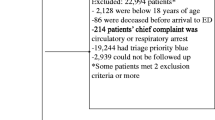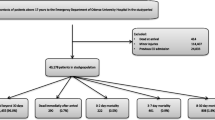Abstract
Background and aims: Hospital admissions from Nursing Homes (NHs) are associated with high mortality. Identifying people with a poor prognosis admitted from NHs is essential to inform appropriate clinical decision making. Methods: We identified all consecutive admissions from NHs (all ages) to an Acute Medical Assessment Unit (AMU) of a large District General Hospital in UK with a catchment population of ∼360,000 between January 2005–December 2007 and reviewed their outcome to end of March 2009 (median follow-up=133 days). The relation between admission vital signs (systolic blood pressure, pulse rate, respiratory rate, body temperature and Glasgow Coma Scale-GCS) and outcomes including in-patient mortality, hospital length of stay and mortality at followup were examined using logistic and Cox regression models. Results: The cohort consisted of 316 patients (32% male), mean age at admission was 83.8 years (SD 8.36 yrs; range=49-99 yrs). Sixty-seven (21%) had at least two admissions during the study period; the maximum number of readmissions was five. We found strong evidence that lower systolic blood pressure and higher respiratory rate at the time of admission were associated with increased probability of in-patient death and reduced survival time but not with length of stay. Older age and lower admission GCS were additionally associated with overall poor prognosis. Conclusion: Simple and readily available hospital admission parameters predict not only the in-patient mortality but also longer term outcome for NH residents who require acute hospital admission. Further studies are required to examine whether opportunities exist to intervene and improve outcome in this patient population.
Similar content being viewed by others
Explore related subjects
Discover the latest articles, news and stories from top researchers in related subjects.References
Subbe CP, Kruger M, Rutherford P, Gemmel L. Validation of a modified Early Warning Score in medical admissions. Q J Med 2001; 94: 521–6.
Paterson R, MacLeod DC, Thetford D et al. Prediction of in-hospital mortality and length of stay using an early warning scoring system: clinical audit. Clin Med 2006; 6: 281–4.
Groarke JD, Gallagher J, Stack J et al. Use of an admission Early Warning Score to predict patient morbidity and mortality and treatment success — a prospective cohort study. Eur J Intern Med 2008; 19: e8.
Cei M, Bartolomei C, Mumoli N. In-hospital mortality and morbidity of elderly medical patients can be predicted at admission by the Modified Early Warning Score: a prospective study. Int J Clin Pract 2009; 63: 591–5.
Rubinstein LZ, Ouslander JG, Wieland D. Dynamics and clinical implications of the nursing home-hospital interface. Clin Geriatr Med 1988; 4: 471–91.
Leach D, Turnberg L. Coping with emergency admissions. Royal College of Physicians of London, March 1997.
Beringer TR, Flanagan P. Acute medical bed usage by nursing home residents. Ulster Med J 1999; 68: 27–9.
Finucane PM, Wundke R, Whitehead C, Williamson L, Baggoley CJ. Profile of people referred to an emergency department from residential care. Aust NZ J Med 1999; 29: 494–9.
Bowman CE, Elford J, Dovey J, Campbell S, Barrowclough H. Acute hospital admissions from nursing homes: some may be avoidable. Postgrad Med J 2001; 77: 40–2.
Ahearn DJ, Jackson TB, McIlmoyle J, Weatherburn AJ. Improving end of life care for nursing home residents: an analysis of hospital mortality and readmission rates. Postgrad Med J 2010; 86: 131–5.
Myint PK, Kamath AV, Vowler SL, Maisey DN, Harrison BD. Severity assessment criteria recommended by the British Thoracic Society (BTS) for community-acquired pneumonia (CAP) and older patients. Should SOAR (systolic blood pressure, oxygenation, age and respiratory rate) criteria be used in older people? A compilation study of two prospective cohorts. Age Ageing 2006; 35: 286–91.
Myint PK, Al-Jawad M, Chacko SM, Chu GS, Vowler SL, May HM. Prevalence, characteristics and outcomes of people aged 65 years and over with an incidental rise in cardiac troponin I. An observational prospective cohort study. Cardiology 2008; 110: 62–7.
Cox DR. Regression models and life tables. J R Stat Soc B 1972; 34: 187–220.
Taylor IC, McConnell JG. Admission of nursing home patients to geriatric medical wards. Ulster Med J 1994; 63: 170–5.
Koval KJ, Zuckerman JD. Functional recovery after fracture of the hip. J Bone Joint Surg Am 1994; 76: 751–8.
Mitchell SL, Kiely DK, Hamel MB. Dying with advanced dementia in the nursing home. Arch Intern Med 2004; 164: 321–6.
Menec VH, MacWilliam L, Aoki FY. Hospitalizations and deaths due to respiratory illnesses during influenza seasons: a comparison of community residents, senior housing residents, and nursing home residents. J Gerontol Med Sci 2002; 57A: M629–35.
Molloy DW, Guyatt GH, Russo R et al. Systematic implementation of an advance directive program in nursing homes, a randomized controlled trial. JAMA 2000; 283: 1437–44.
Mott PD, Barker WH. Hospital and medical use by nursing home patients: the effect of patient care plans. J Am Geriatr Soc 1988; 36: 47–53.
Author information
Authors and Affiliations
Corresponding author
Rights and permissions
About this article
Cite this article
Myint, P.K., Trepte, N.J.B., Parker, R.A. et al. Vital signs as determinants of immediate and longer term mortality outcome of patients admitted from Nursing Homes. Aging Clin Exp Res 23, 309–315 (2011). https://doi.org/10.1007/BF03337756
Received:
Accepted:
Published:
Issue Date:
DOI: https://doi.org/10.1007/BF03337756




